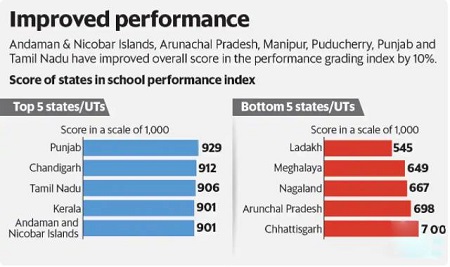Governance
Performance Grading Index (PGI)
- 07 Jun 2021
- 5 min read
Why in News
The Union Education Minister has approved the release of Performance Grading Index (PGI) 2019-20 for States and Union Territories.
- The PGI is a tool to provide insights on the status of school education in States and UTs including key levers that drive their performance and critical areas for improvement.
Key Points
- About the Performance Grading Index (PGI):
- Background: The PGI for States and Union Territories was first published in 2019 with reference year 2017-18.
- The PGI : States/UTs for 2019-20 is the third publication in this series.
- Objectives:
- The PGI exercise envisages that the index would propel States and UTs towards undertaking multi-pronged interventions that will bring about the much-desired optimal education outcomes.
- The PGI helps the States/UTs to pinpoint the gaps and accordingly prioritise areas for intervention to ensure that the school education system is robust at every level.
- Implementing Agency:
- It is initiated by the Department of School Education and Literacy (DoSEL).
- Source of Information:
- The information on the indicators are drawn from data available with the DoSEL from the Unified District Information System for Education (UDISE), National Achievement Survey (NAS) of NCERT, Mid Day Meal website, Public Financial Management System (PFMS) and the information uploaded by the States and UTs on the Shagun portal of DoSEL.
- Methodology:
- The PGI is structured in two categories, namely, Outcomes and Governance & Management and comprises 70 indicators in aggregate with a total weightage of 1000.
- Domains under categories include: Access, Infrastructure & Facilities, Equity, Governance process.
- Background: The PGI for States and Union Territories was first published in 2019 with reference year 2017-18.
- Important Findings of the PGI 2019-20:
- State-wise Performance:
- Shows that 33 States and UTs have improved their PGI scores in 2019-20 compared to the previous year.
- Andaman and Nicobar Islands, Arunachal Pradesh, Manipur, Puducherry, Punjab and Tamil Nadu have improved their overall PGI scores by 10%.
- Inter-state Differential:
- On a maximum possible of 1000 points, the range between the States and UTs with the highest and the lowest score is more than 380 points in the year 2019-20.
- State-wise Performance:
- Domain-wise Performance:
- Access: Andaman and Nicobar Islands, Lakshadweep and Punjab have shown improvement of 10% or more in the ‘Access’ domain.
- Infrastructure and Facilities: Thirteen states and UTs have shown improvement by 10% or more in ‘Infrastructure and Facilities’ while Andaman and Nicobar Islands and Odisha have improved their scores in the domain by 20% or more.
- Equity: In ‘Equity’, Arunachal Pradesh, Manipur and Odisha have shown an improvement of more than 10%.
- Governance Process: 19 states have shown improvement by 10% or more.
- Andaman and Nicobar Islands, Andhra Pradesh, Arunachal Pradesh, Manipur, Punjab, Rajasthan and West Bengal have shown improvement by at least 20%.
Way Forward
- A reliable, timely and participative information system coupled with a robust and efficient data analytics framework is the key to successful implementation of any Government programme.
- In the arena of School Education & Literacy, guided by the enabling legislative framework of the Right to Education, the National Education Policy 2020 and visionary Sustainable Development Goals (SDGs), Government Schemes like Samagra Shiksha (SS), Mid-Day Meal (MDM) and similar such schemes by the States would deliver the desired result if they are monitored effectively.
- The framework of a real time data availability system (namely, UDISE+, Shagun, etc.) and an objective and holistic performance evaluation framework provided through the PGI would provide the right combination for effective implementation of policy in the School Education sector.
- A performance-based grant would provide the required incentive to the States and UTs to ensure their continuous and focused attention to this sector, which is crucial for overall growth and development of the country.







